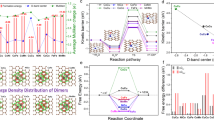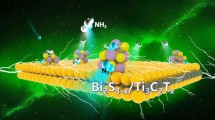Abstract
The electrocatalysis of CO2 reduction to formic acid (HCOOH) as a useful chemical fuel has attracted much attention, but is facing the dilemma of low conversion efficiency. Herein, a series of transition elements were intentionally implanted into layered Bi2SeO2 surface to act as bimetallic reactive sites for decreasing the rate-limiting barriers. The calculations disclose that the doped 3d-metals can partially changes the electronic state distribution of 6 s lone pair electrons in Bi3+cation, in which this particular orbital hybridization leads to an intriguing bonding interaction between dopants and neighboring Se/O atomic layers. This interlayer electronic state coupling makes the half-filled dopants demonstrate the spin-resolved charge transfer and orbital interaction between bimetallic sites and reactants, because of the localized atomic distortion and electronic reconfiguration. This work provides a new insight into engineering surficial electronic structure and catalytic activity.
Graphical Abstract






Similar content being viewed by others
References
Sun Z, Ma T, Tao H, Fan Q, Han B (2017) Fundamentals and challenges of electrochemical co2 reduction using two-dimensional materials. Chem 3:560–587
Zhang L, Zhao ZJ, Gong J (2017) Nanostructured materials for heterogeneous electrocatalytic CO2 reduction and their related reaction mechanisms. Angew Chem Int Ed 56:11326–11353
Wang Q, Lei Y, Wang D, Li Y (2019) Defect engineering in earth-abundant electrocatalysts for CO2 and N2 reduction. Energy Environ Sci 12:1730–1750
Zhang J, Chen M, Li H, Li Y, Ye J, Cao Z, Fang M, Kuang Q, Zheng J, Xie Z (2018) Stable palladium hydride as a superior anode electrocatalyst for direct formic acid fuel cells. Nano Energy 44:127–134
Wu Z, Wu H, Cai W, Wen Z, Jia B, Wang L, Jin W, Ma T (2021) Engineering bismuth-tin interface in bimetallic aerogel with a 3d porous structure for highly selective electrocatalytic CO2 reduction to HCOOH. Angew Chem Int Ed 60:12554–12559
Zhang LY, Gong Y, Wu D, Li Z, Li Q, Zheng L, Chen W (2019) Palladium-cobalt nanodots anchored on graphene: In-situ synthesis, and application as an anode catalyst for direct formic acid fuel cells. Appl Sur Sci 469:305–311
El-Nagar GA, Mohammada AM, El-Deab MS, El-Anadouli BE (2017) Propitious dendritic Cu2O–Pt nanostructured Anodes for direct formic acid fuel cells. ACS Appl Mater Interfaces 9:19766–19772
Sordakis K, Tang C, Vogt LK, Junge H, Dyson PJ, Beller M, Laurenczy G (2018) Homogeneous catalysis for sustainable hydrogen storage in formic acid and alcohols. Chem Rev 118:372–433
Xing Y, Kong X, Guo X, Liu Y, Li Q, Zhang Y, Sheng Y, Yang X, Geng Z, Zeng J (2020) Bi@Sn core-shell structure with compressive strain boosts the electroreduction of CO2 into formic acid. Adv Sci 7:1902989
Zheng X, De Luna P, García de Arquer FP, Zhang B, Becknell N, Ross MB, Li Y, Banis MN, Li Y, Liu M, Voznyy O, Dinh CT, Zhuang T, Stadler P, Cui Y, Du X, Yang P, Sargent EH (2017) Sulfur-modulated tin sites enable highly selective electrochemical reduction of CO2 to formate. Joule 1:794
Guo YB, Yao S, Xue YY, Hu X, Cui HJ, Zhou Z (2022) Nickel single-atom catalysts intrinsically promoted by fast pyrolysis for selective electroreduction of CO2 into CO. Appl Catal B 304:120997
Zhang X, Zhou Z (2022) Perspective on theoretical models for CO2 electrochemical reduction. J Phys Chem C 126:3820–3829
Jiang B, Zhang XG, Jiang K, Wu DY, Cai WB (2018) Boosting formate production in electrocatalytic CO2 reduction over wide potential window on Pd surfaces. J Am Chem Soc 140:2880–2889
Wei F, Wang T, Jiang X, Ai Y, Cui A, Cui J, Fu J, Cheng J, Lei L, Hou Y, Liu S (2020) Controllably engineering mesoporous surface and dimensionality of SnO2 toward high-performance CO2 electroreduction. Adv Funct Mater 30:2002092
Deng P, Wang H, Qi R, Zhu J, Chen S, Yang F, Zhou L, Qi K, Liu H, Xia BY (2020) Bismuth oxides with enhanced Bismuth-oxygen structure for efficient electrochemical reduction of Carbon dioxide to formate. ACS Catal 10:743–750
Lee CH, Kanan MW (2015) Controlling H+ vs CO2 reduction selectivity on Pb electrodes. ACS Catal 5:465–469
Zhang A, Liang Y, Li H, Zhao X, Chen Y, Zhang B, Zhu W, Zeng J (2019) Harmonizing the electronic structures of the adsorbate and catalysts for efficient CO2 reduction. Nano Lett 19:6547–6553
Zhang X, Sun X, Guo SX, Bond AM, Zhang J (2019) Formation of lattice-dislocated bismuth nanowires on copper foam for enhanced electrocatalytic CO2 reduction at low overpotential. Energy Environ Sci 12:1334–1340
Li T, Tu T, Sun Y, Fu H, Yu J, Xing L, Wang Z, Wang H, Jia R, Wu J, Tan C, Liang Y, Zhang Y, Zhang C, Dai Y, Qiu C, Li M, Huang R, Jiao L, Lai K, Yan B, Gao P, Peng H (2020) A native oxide high-κ gate dielectric for two-dimensional electronics. Nat Electron 3:473–478
Kresse G, Furthmuller J (1996) Efficient iterative schemes for ab initio total-energy calculations using a plane-wave basis set. Phys Rev B 54:11169
Perdew JP, Burke K, Ernzerhof M (1996) Generalized gradient approximation made simple. Phys Rev Lett 77:3865
Peterson AA, Abild-Pedersen F, Studt F, Rossmeisl J, Nørskov JK (2010) How copper catalyzes the electroreduction of carbon dioxide into hydrocarbon fuels. Energy Environ Sci 3:1311–1315
Shan Y, Liu FC, Liu LZ (2022) Electronic reconfiguration in layered Bi2SeO2 surface induced by dual-metal hybridization for hydrogen evolution reaction. Surf Interfaces 29:101779
Gajdoš M, Hummer K, Kresse G, Furthmüller J, Bechstedt F (2006) Linear optical properties in the projector-augmented wave methodology. Phys Rev B 73:045112
Yang F, Elnabawy AO, Schimmenti R, Song P, Wang J, Peng Z, Yao S, Deng R, Song S, Lin Y, Mavrikakis M, Xu W (2020) Bismuthene for highly efficient carbon dioxide electroreduction reaction. Nat Commun 11:1088
Zhang QQ, Guan JQ (2020) Single-atom catalysts for electrocatalytic applications. Adv Funct Mater 30:2000768
Jia L, Yang H, Deng J, Chen JM, Zhou Y, Ding P, Li LG, Han N, Li YG (2019) Copper-bismuth bimetallic microspheres for selective electrocatalytic reduction of CO2 to formate. Chin J Chem 37:497–500
Acknowledgements
This work was supported by National Natural Science Foundation of China (Grant Nos. 21872071 and 61964004) and high Performance Computing Centers of Shenzhen.
Author information
Authors and Affiliations
Corresponding authors
Ethics declarations
Conflict of interest
The authors declare that they have no known competing financial interests or personal relationships that could have appeared to influence the work reported in this paper.
Additional information
Publisher's Note
Springer Nature remains neutral with regard to jurisdictional claims in published maps and institutional affiliations.
Rights and permissions
Springer Nature or its licensor holds exclusive rights to this article under a publishing agreement with the author(s) or other rightsholder(s); author self-archiving of the accepted manuscript version of this article is solely governed by the terms of such publishing agreement and applicable law.
About this article
Cite this article
Shan, Y., Sun, X., Zhu, Y. et al. Dopant-driven Interlayer Electronic State Coupling in Layered Bi2SeO2 Surface for Accelerating CO2 Reduction to HCOOH. Catal Lett 153, 1839–1846 (2023). https://doi.org/10.1007/s10562-022-04129-6
Received:
Accepted:
Published:
Issue Date:
DOI: https://doi.org/10.1007/s10562-022-04129-6




